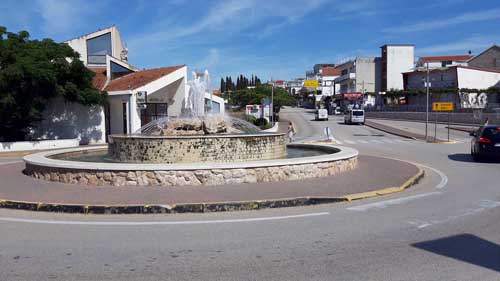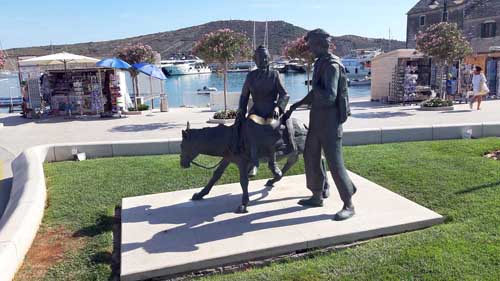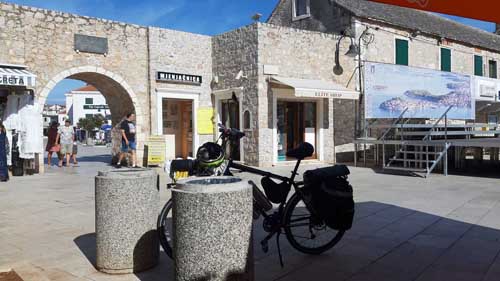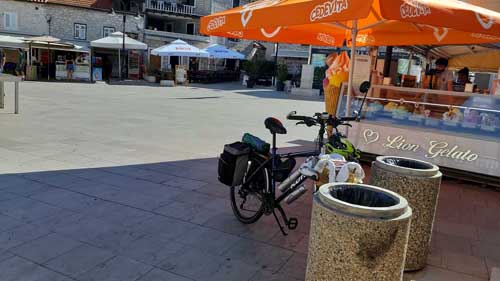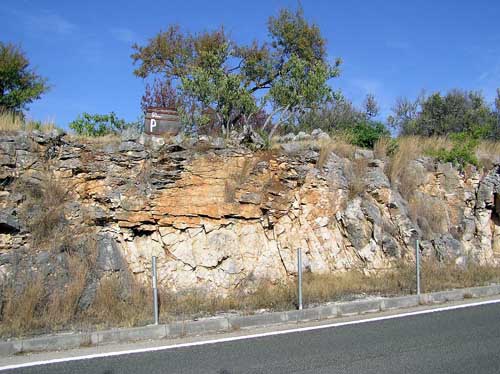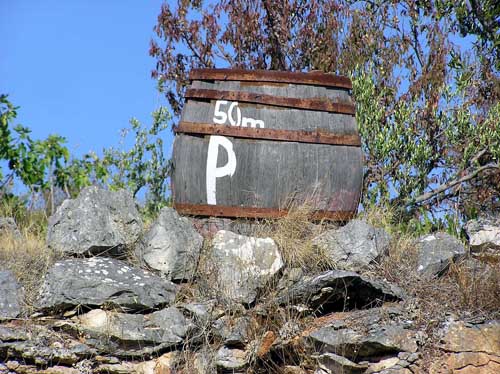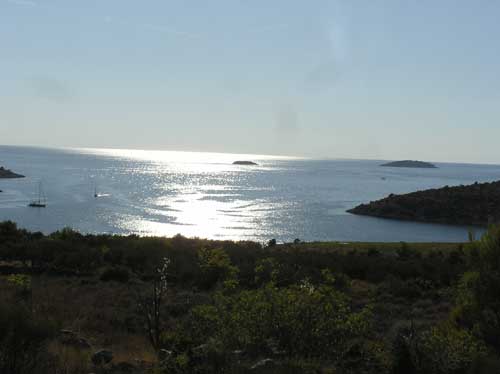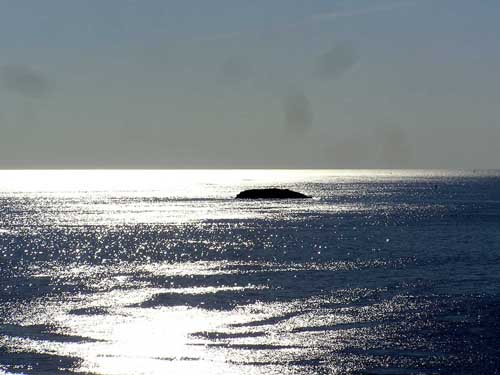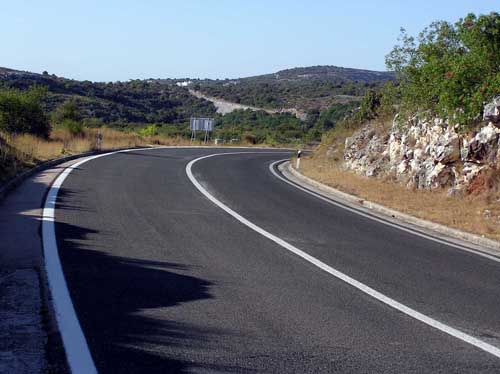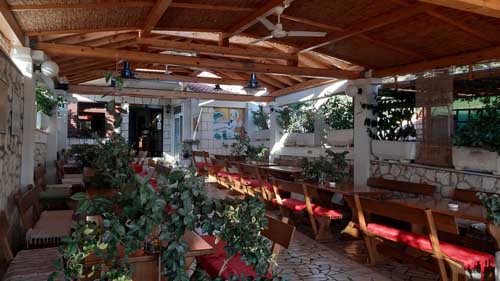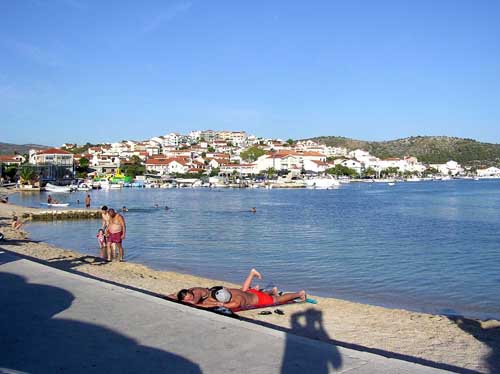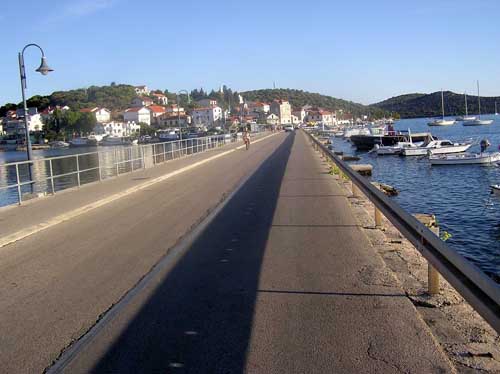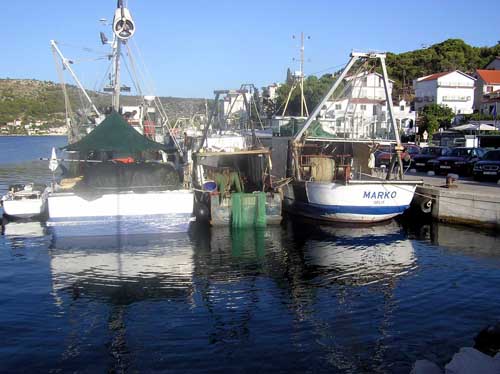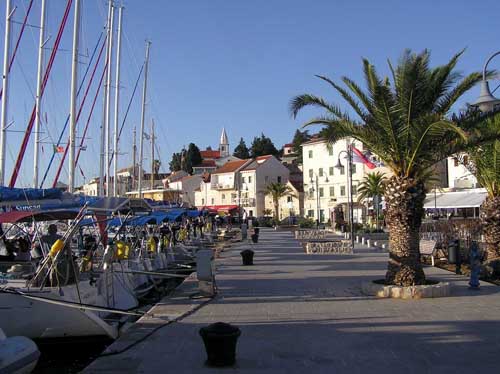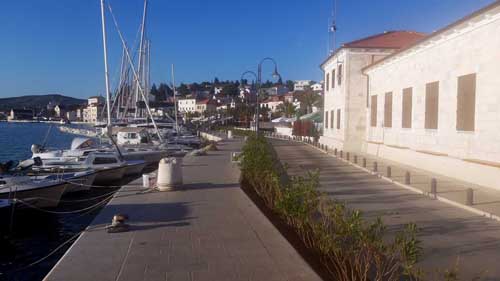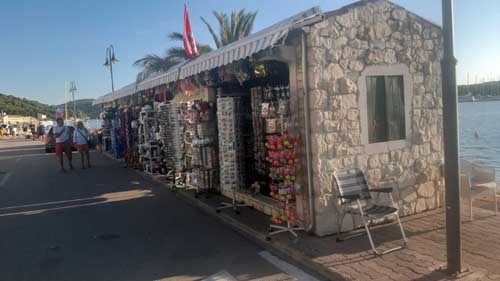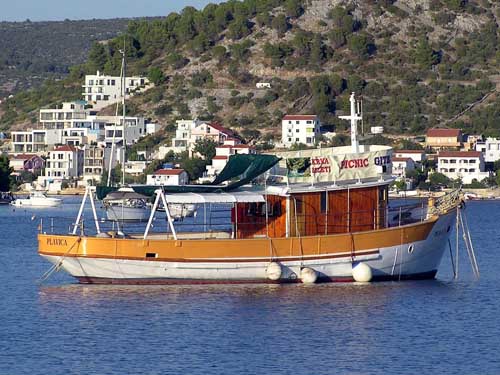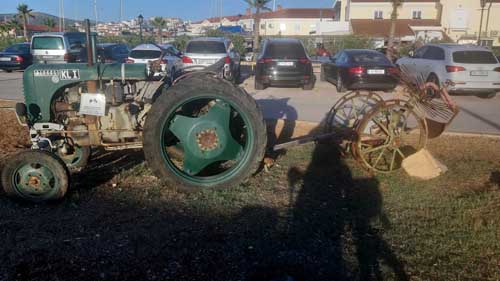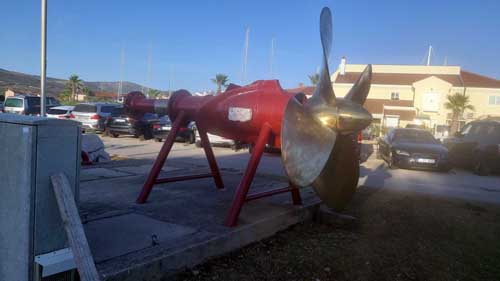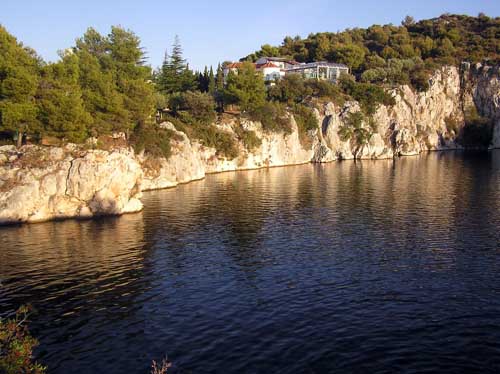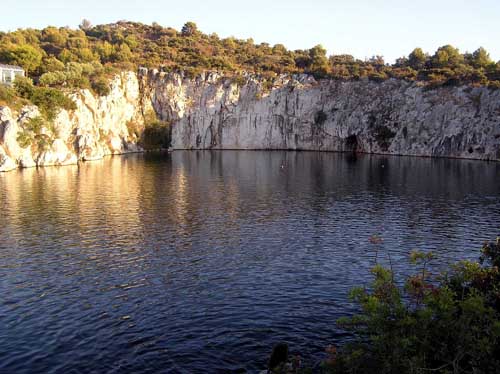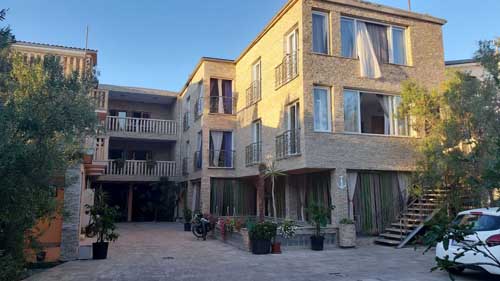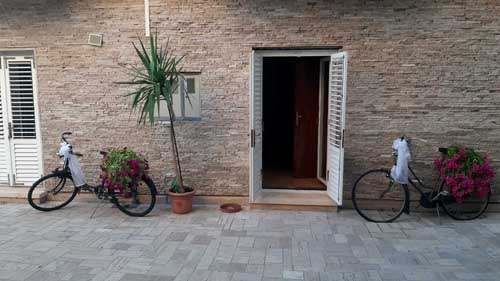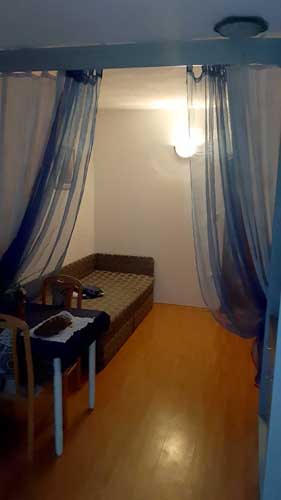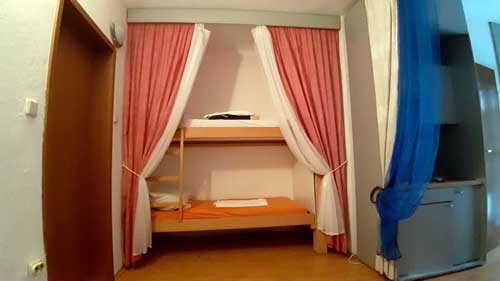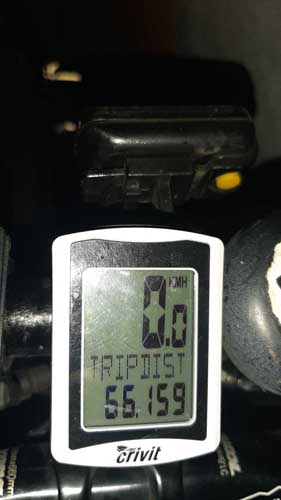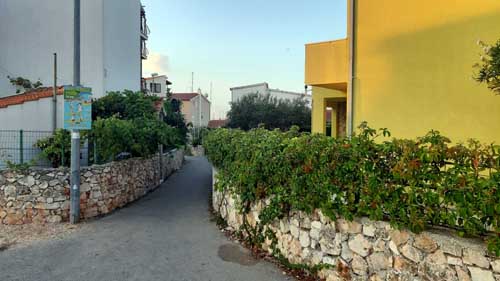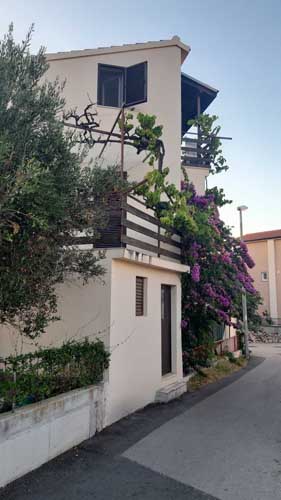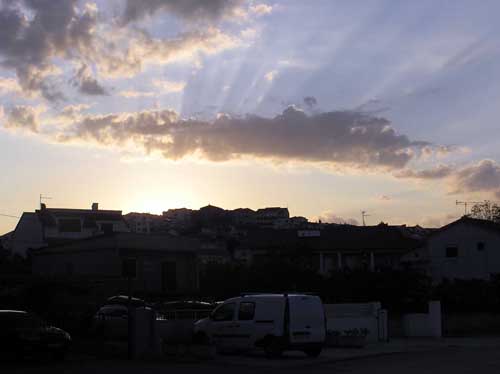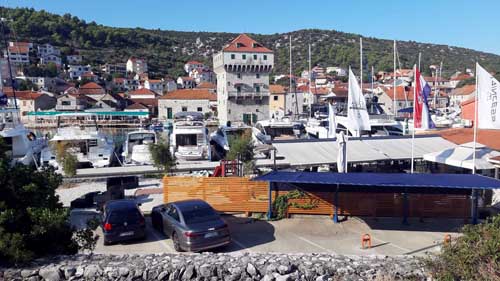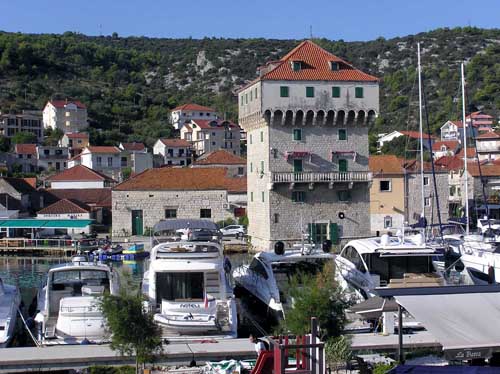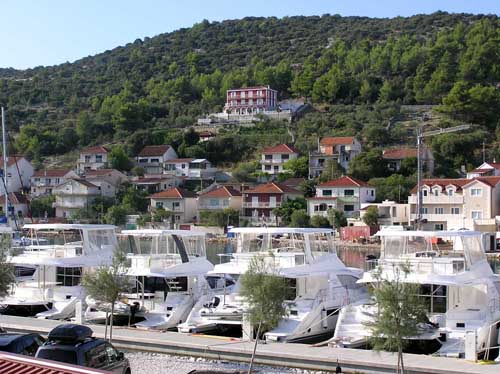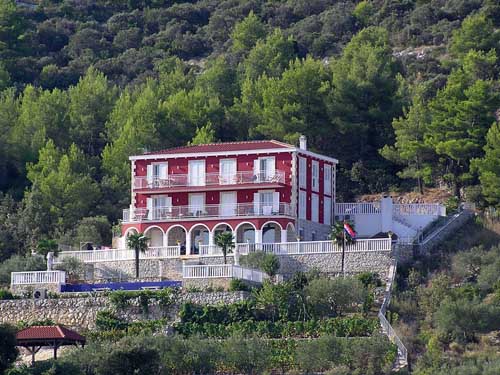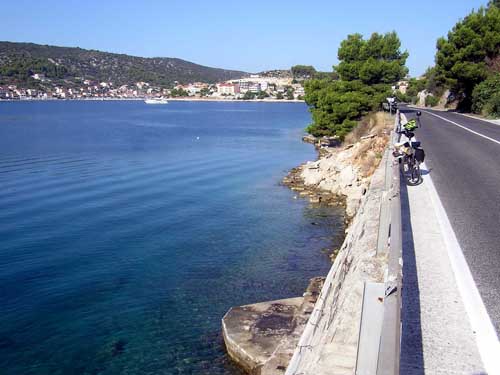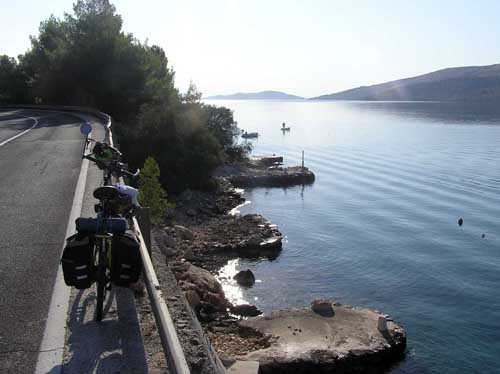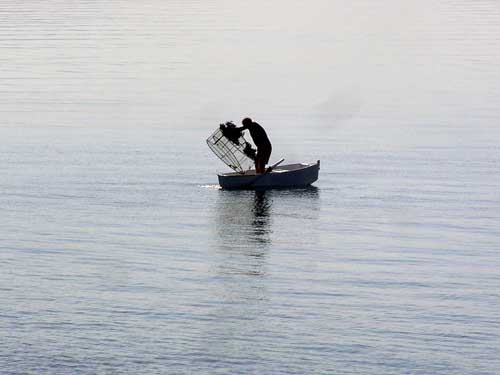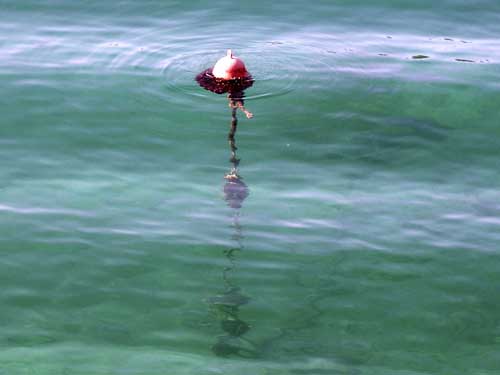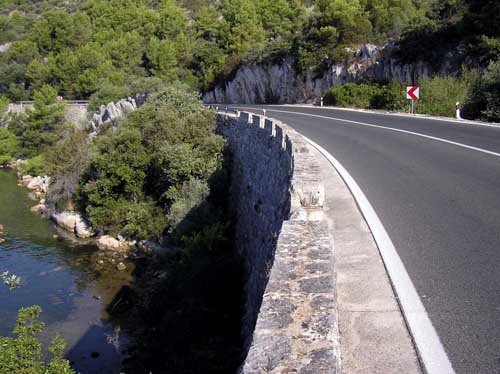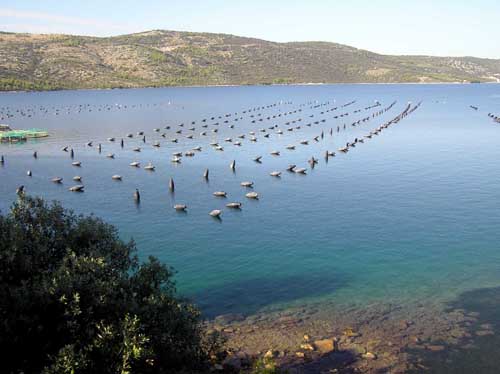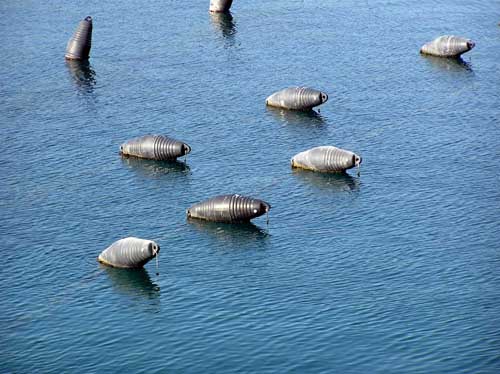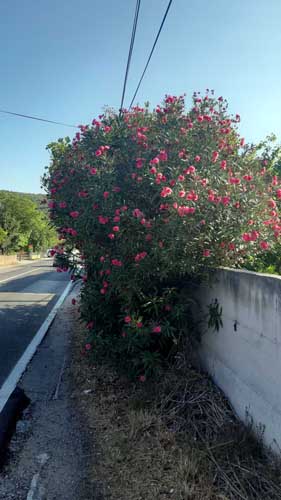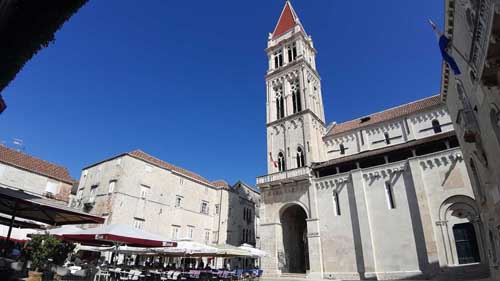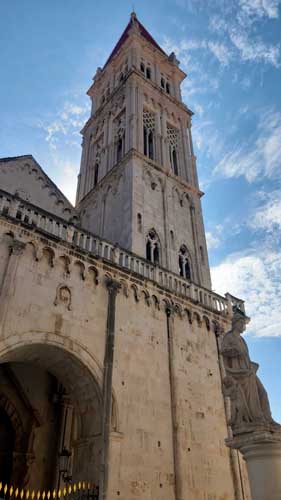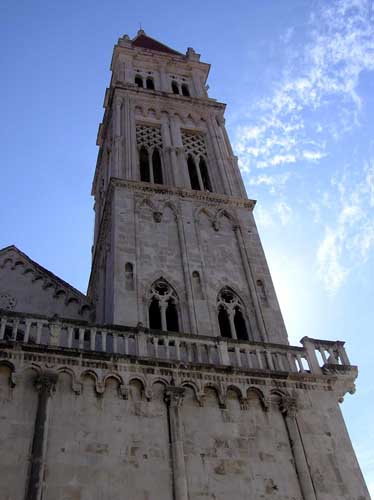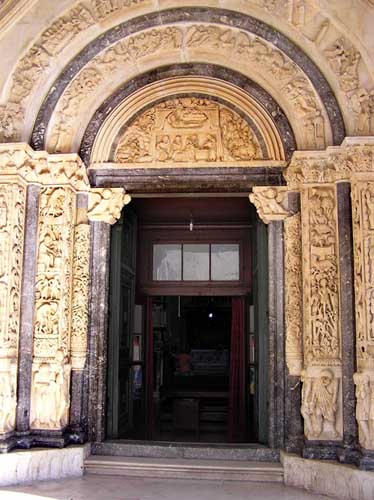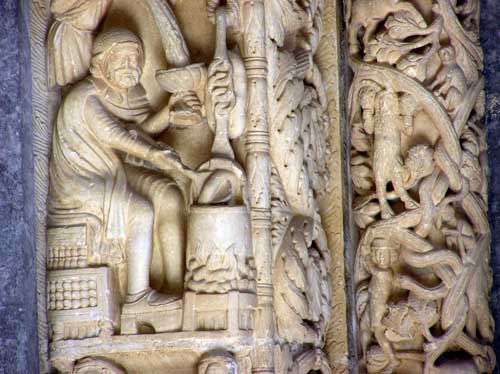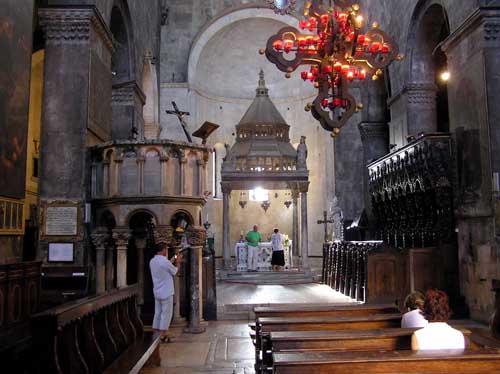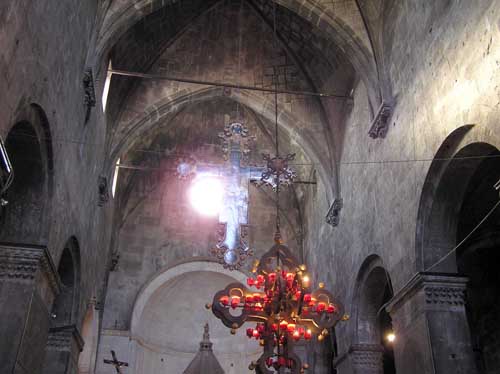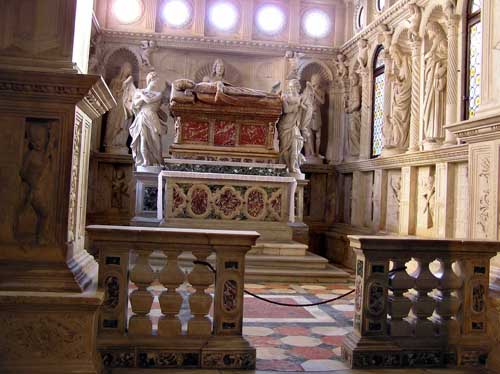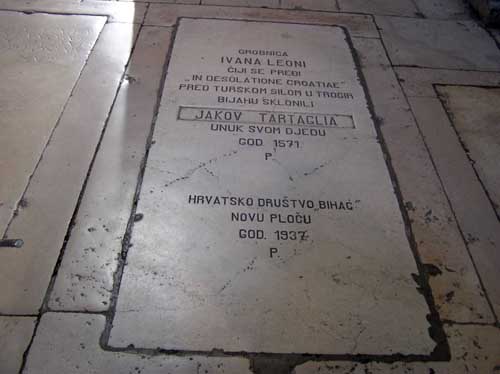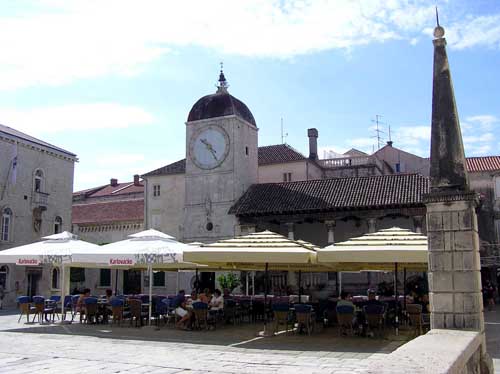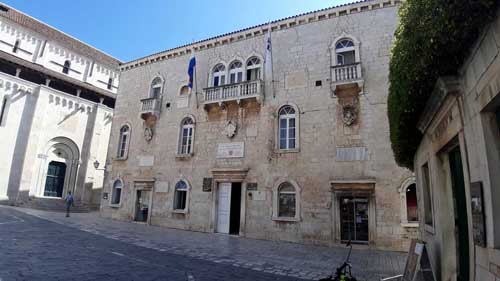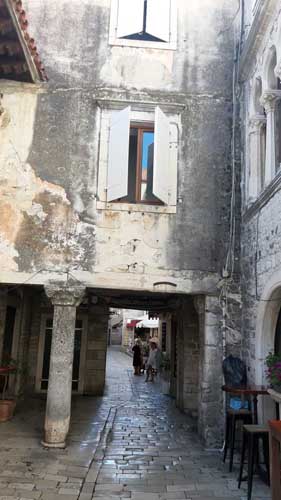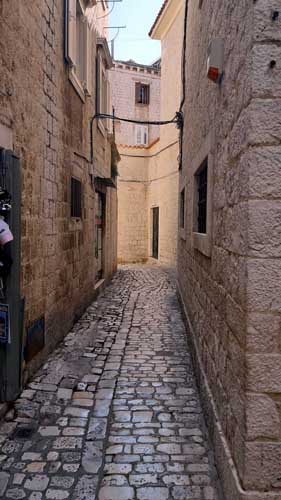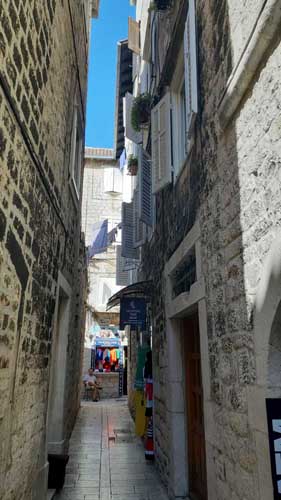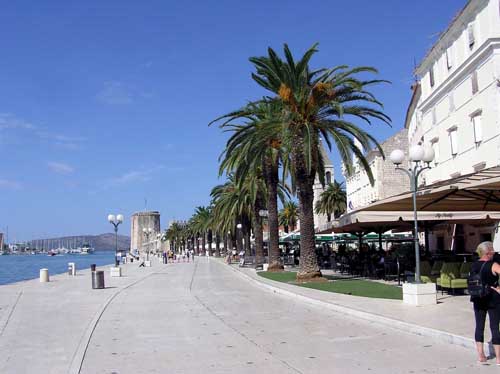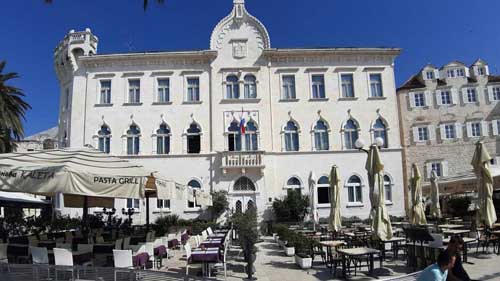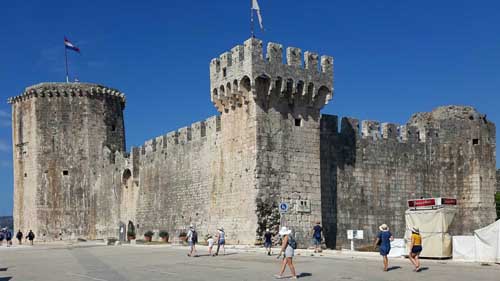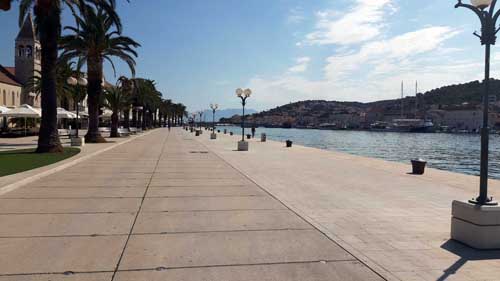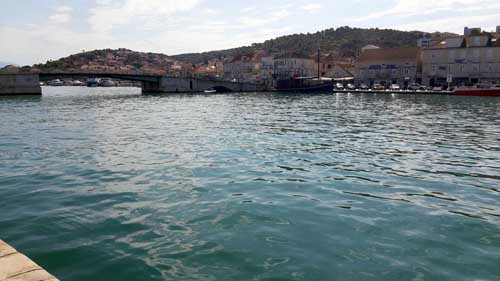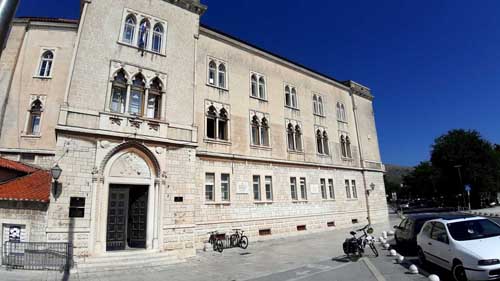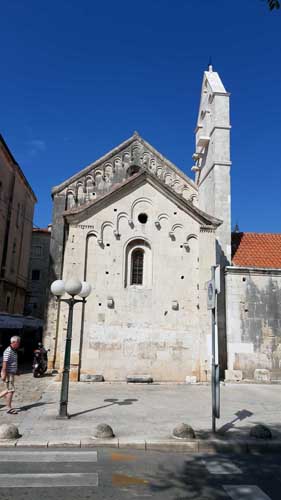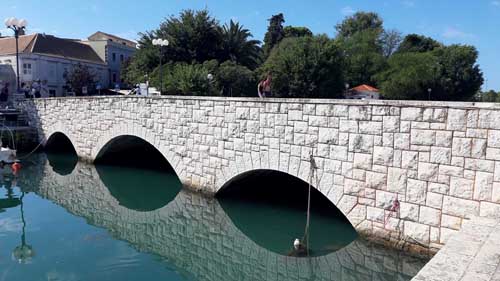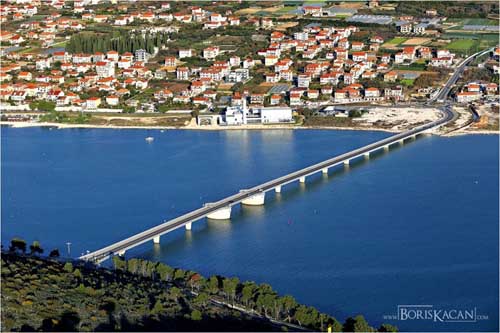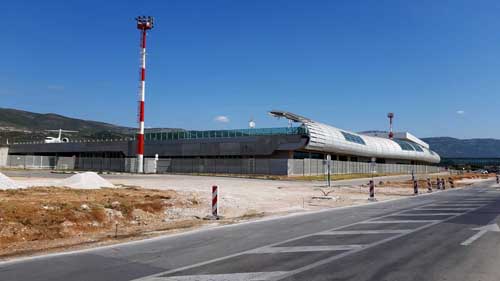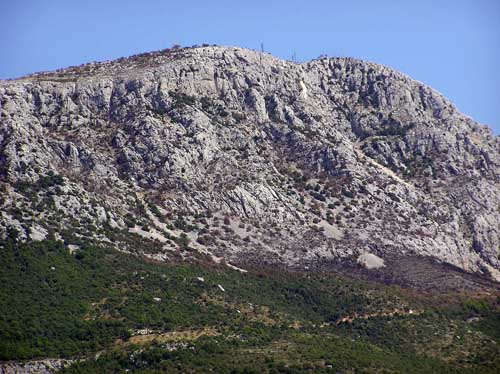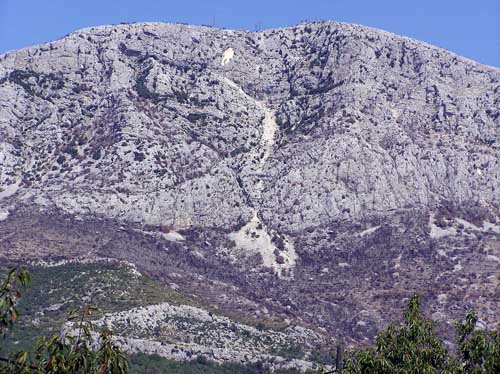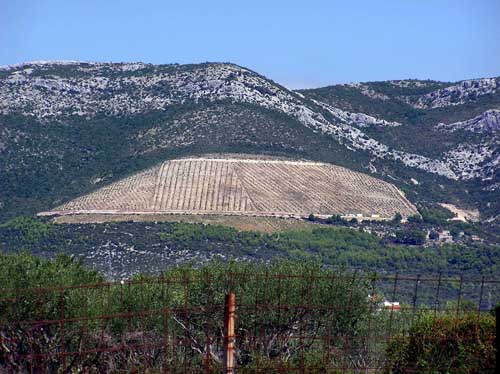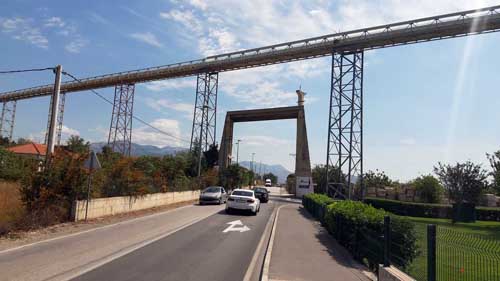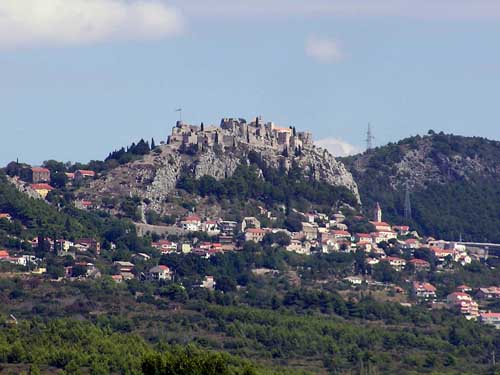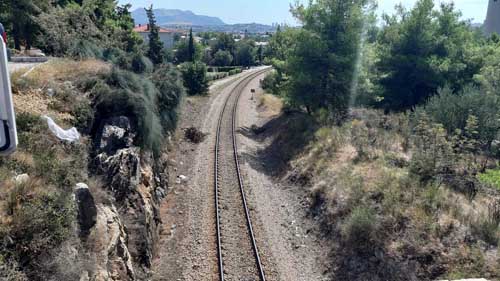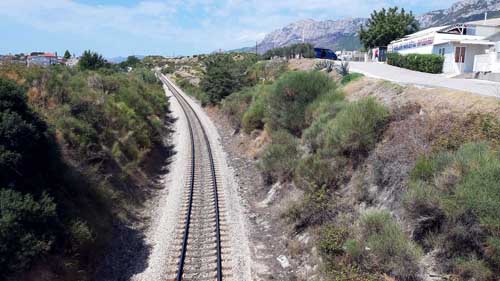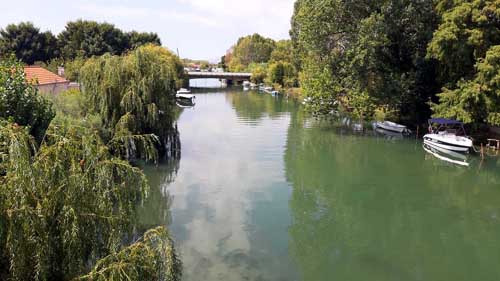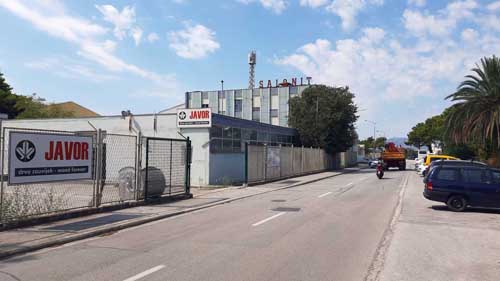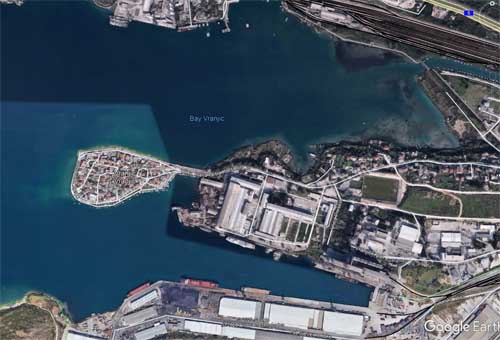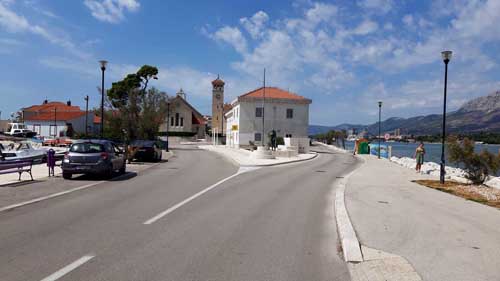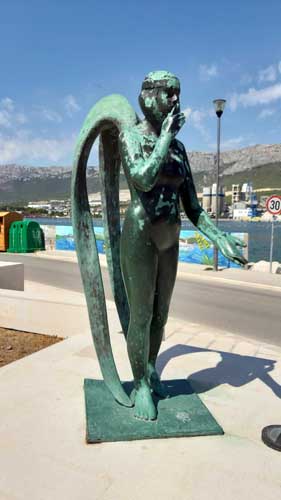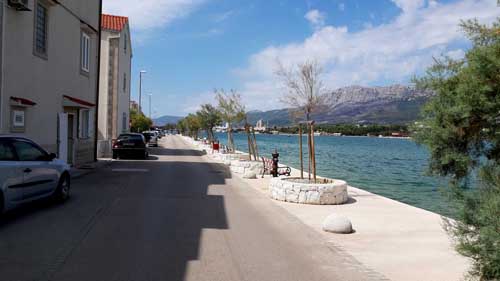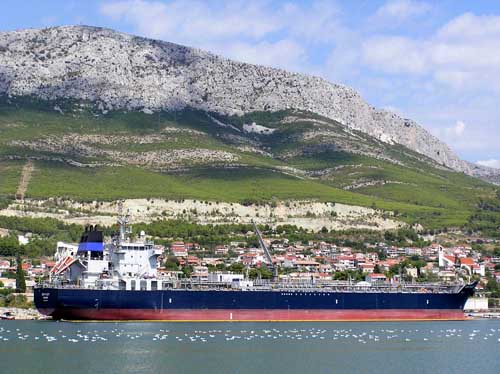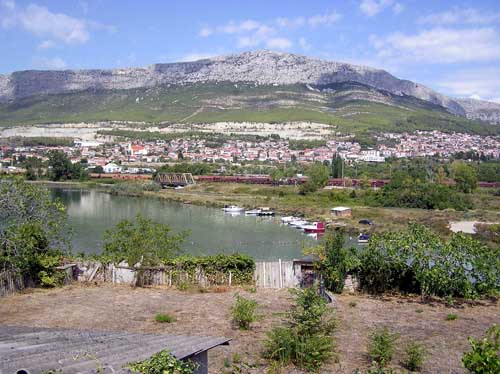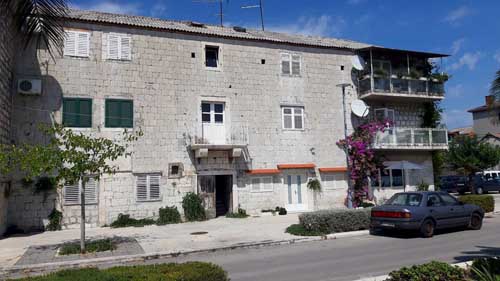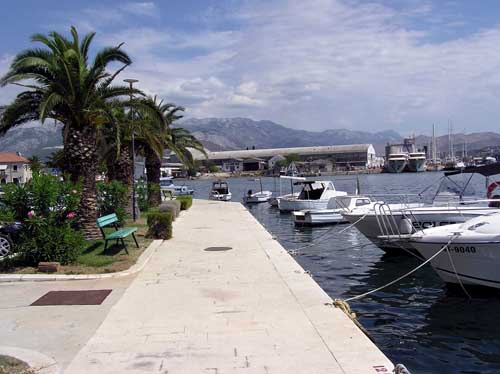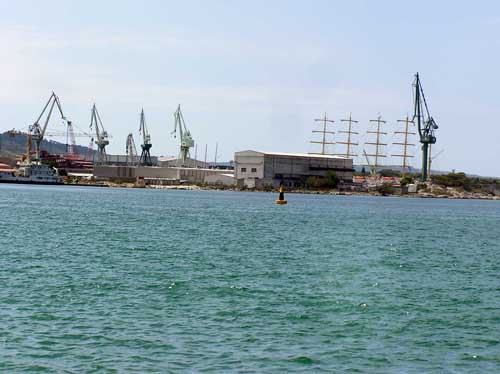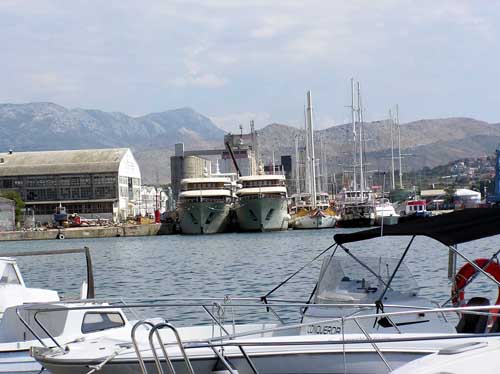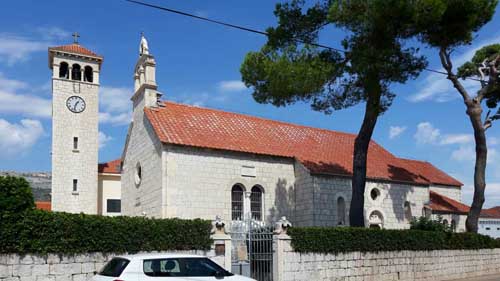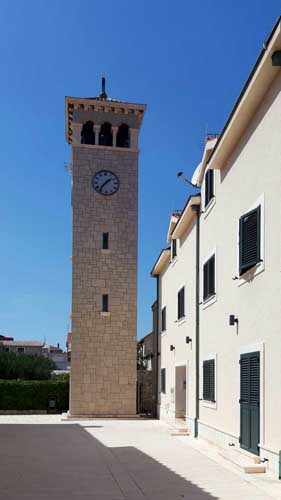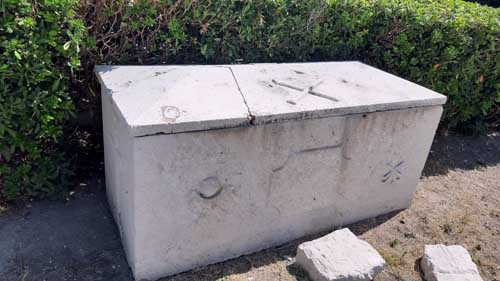Marketing
Knin - Split 2020 Part Three
You can come back on the previous part of this travelogue here.
And finally the Primosten town!
I turned right off the main road, descending into the town I came to a lavish roundabout.
After rebuilding the liquid at a nearby store, I continued towards the center of the town where I came across an interesting sculpture. It was a monument to the peasant, depicting grandmother and grandfather and their faithful ally, which is a symbol of the Primosten town - a donkey.
I went through a kind of stone gateway and entered a larger square. It was hot, too hot, so I found cooling in the ice cream. There was a bench in the shade, in front of the patisserie, where I sat and cooled my body and soul.
I was in a dilemma.
Should I wait for the heat to pass, by then tour the place, and before the evening go to the Rogoznica town, where I will spend the night tonight, or continue immediately towards it?
As the heat presses, I'm afraid that from the tour, and some pleasure in it will not be much. After all, I stopped touring Šibenik because of the heat.
I let, and longer than I initially thought, that my brain try to put together two meaningful thoughts in this heat.It, too, was obviously not able to work, but joined to the body, which was simply rested in this kind of shade.
After a while, and I don't know how many time, I got up, took my bike and left this boiling town.
After the ascent on which I descended to this place, and exiting on the main road, I continued - uphill. In fact it wasn’t some overly steep so I even drove.
I passed some road workers, who were doing something on some extension of the road in this heat. They paused for a moment in their work and looked at me sympathetically. Catching their eye, I asked them how more to the Rogoznica town, to which they answered cheerfully; "Not so far, just 7-8 km!", obviously in an effort to somehow cheer me up, empower me to endure in this struggle with the heat, as theirs was.
A little further on, on that uphill that lengthened well, an interesting sign for a parking lot that I should come across in some 50 meters caught my attention.
Again some nameless islet appeared, this time so little that I didn't notice any of the vegetation on it. Since the sun was shining in my eyes, it was harder to notice if there was anything on the island. Here are the images for you, so judge whether my conclusion about life on the mentioned island is correct or not.
At the end of this long uphill, on some kind of pass, I turned to see what I had been through a little while before.
Why do the uphills are so long and painfully, and at the same time the downhills be so short that you can't rest honestly and refresh yourself with a breeze while driving?
Why does the sun heat up so fiercely?
Why did I even allow to be persuaded by myself, into this currently hot trip?
Why....
Those "whys" would be countless, if they were not interrupted by one notice intended for all passengers on the road, including me, in the form of a large, yellow sign that read "Rogoznica". At the same moment, in just a hundredth of a second, my depressing, on the verge of despair, the mental state changed radically. I was overwhelmed by a sense of triumph, victory, radiance and happiness.
I succeed!!!!
No more fatigue, although it was hot just the same.
No more discouragement, although it was hot just the same.
I turned off the main road and downhill, which improved my condition even more, both physically and mentally, and came to the waterfront. It was only 5.30 pm, so there was plenty of time, whatever comes to my mind.
I remembered last night's modest dinner, so I decided to make it richer this time. So I turned into the pizzeria I came across. The pizzeria had a large terrace, but no guests. The coronavirus has done its part in terms of the number of tourists this year's tourist season.
I sat down at a table right next to the entrance so there was my bicycle on the other side of the stone wall. It was in my sight. Just in case.
After a pizza-shaped dinner and two draft beers, while I was paying the bill, the waiter brought me a glass of brandy with the comment “ gift of the house!”. I thanked him, as kindly as I could, and only lightly licked the alcoholic drink. I waited for him to leave, so I left, leaving the "gift of the house" on the table. I’m not a fan of a hard drink anyway, and now, so exhausted, it seems to me that the consequences of consuming that drink would be incalculable.
Rogoznica is a small town on the Adriatic coast whose population ratio between winter and summer is around 1: 1000. In addition, it has a reputation for a higher price for summer vacation, which I saw in the price of my accommodation. But about that later.
Let's take a look around the city first.
As I said, a small coastal town, so along the coast were the road, the promenade and the beach, all next to each other.
Now, I have a dilemma about whether to show you some of the following images.
They don’t show anything compromising, not at all! The problem is my negligence, which to some extent, only to some extent, can be justified by a fiercely hot day and my fatigue as a result of it.
Although I tried to keep my cell phone and camera lenses clean, whether with considerate care or a tissue, all this time, I forgot about it this time, so some of the following shots are strangely blurry. They are like that because they coated with dirt and sweat that was on my fingers.
I will show them anyway, and I beg you, my faithful reader, once again for forgiveness.
While planning this trip, I noticed two interesting things in the Rogoznica town that seemed is worthy of my attention.
The first was an islet in the village itself. In fact, with the levee along which the road goes, the islet became a peninsula.
On the island or the peninsula, nothing special, but yet interesting and nice enough.
I was surprised by the fishing boats in a place that I assumed was exclusively touristy.
But I was not surprised by a large number of sailboats along the waterfront.
The landscaping of the waterfront was impressive for me.
There was also a standard tourist offer of small things, located here in a stone-built "business premises".
On the way back, I took a picture of the cute little tourist boat was abundantly sunny.
I returned by levee to the mainland (unlike this one on the peninsula). As an engineer, I was interested in two exhibits in the park. The first was some old tractor with a hitch for, it seems to me, extracting potatoes or beets. The other was a big propeller assembly, apparently from some ship.
Another attraction of the Rogoznica town, which I thought was worth my attention, is the lake called Dragon's Eye (Zmajevo oko).
According to Wikipedia, the Dragon's Eye is elliptical. It located on the Gradina peninsula in the Rogoznica town. It is filled with saltwater and deeply cut into rocks overgrown with macchia and lower vegetation. It is connected to the sea by a cave whose entering can be seen on the surface of the water. The cave is called the Dragon's Ear and is larger and deeper than the lake itself. An unusual occurrence in the lake occurs every few years. Then its inhabitants (fish, jellyfish, turtles and other sea animals) leave the lake and go through the passage towards the sea. The lake becomes turbid, and when it is purged again after some time, the marine animals return to the lake again and continue to live there until the next such occurrence.
In the scientific sense, the Dragon's Eye is a kind of hydrological and geomorphological phenomenon because intense biochemical processes take place in it, so we can consider it a natural bioreactor.
So much about the Rogoznica town. It was time to find a place to spend the night.
Interestingly, while I was in a telephone arrangement for an overnight stay a few days before the trip, while talking to the hostel's owner, I mentioned him that I would be a bicycle ride for several days and that I was looking for accommodation overnight. To this, he told me that this pleasure would cost me 300 HRK (40 €). It was a little too much for me, but for the first time I am organizing my trip this way, so I humbly accepted the price. But, after half an hour, my cell phone rings and the said owner answers and tells me that he has sympathy for cyclists, so the price will certainly be acceptable to me.
And it was. An overnight stay in Rogoznica cost me 200 HRK (27 €).
After a long search through the narrow streets, I found a luxurious building in which an empty room is hidden, which was already impatient in anticipation of my arrival.
At the entrance to my room were two bicycles, which has not been taken for riding for a long time and now play the role of some fine decoration. This was proof to me that the owner of this hostel is bike-friendly.
My room was a real little apartment. There was a table with chairs, a small kitchen with a stove and a sofa for resting.
A bunk bed with a real canopy was Across from the sofa, looking at the image above. Later, while I slept, the buzzing of mosquitoes around my ear will prove that canopy has a practical purpose, not just the decorative role.
After showering, resting, and calming my soul and body, happy and content with this day, I fell asleep on the lower bed in the dream of the righteous.
Of the three days of this trip, this one should be the most difficult, both in kilometres and in the difference of altitude, and, after all, in the heat. And so it was. And so it would be.
Here are the kilometres travelled on the second day of this journey.
The day third
You can see the map of the second day of the journey here.
In addition to the mosquitoes already mentioned, my sleep was also disturbed by the heat (again, I'm talking about that heat), which hasn't subsided as much as I expected since the yesterday's day. Still, even before the sun came up, I was already on my bike riding through that labyrinth of narrow streets.
I was passing by luxurious houses, apparently currently in the function of private accommodation in the rooms and apartments inside them. Near of one house I was drawn by an abundant bush of a flower which, it seems to me, is called a bougainvillaea.
Arriving at the waterfront while I started to search a store, my attention was drawn by the situation in the east which heralded the imminent appearance of the sun.
After finding a shop at the very exit from Rogoznica, and breakfast in its parking lot, I started pedalling a little after 7.30 am. Going out on the Adriatic main road, I first drove a little downhill and then a slight uphill which was very long - even over 4 km. The road here was separated from the coast, so I turned to the karst interior. The ride through that interior took to the Marina place.
I'm ashamed to admit, but I didn't film a single image of those ten kilometres, from Rogoznica to that Marina. The reason for this was both objective and subjective.
Objectively, there was nothing special in those kilometres. My general impression was the morning freshness, quite rare traffic and a wide, really wide road, with a slight uphill that was fine to drive on. All this enumerated in the last sentence made my thoughts wander somewhere, that the pedals turn almost on their own and that, in the end, I get the impression of really great driving pleasure, although there is no specific reason for that.
Subjectively, I have to admit that I am still under the impression of a fiercely hot day yesterday, and I would like to drive as many kilometres as possible today in the shade of the morning.
And so, completely unexpectedly after a short but steeper downhill ( the downhills always seem to be shorter then uphills), I entered in that Marina place.
The main road leaves a place on the right and continues along the coast, in fact just above it. Looking at it from the bike as I ride, the place didn't look very attractive to me. It even seemed to be a kind of cluttered, some crowd in it, by vehicles, houses and boats. But, I noticed two scenes, however, that caught my attention.
The first is a stone tower in the middle of the town. According to Wikipedia, the bishops of Trogir (Franjo Maracel) built a square tower (castle, bishop's tower) on a small island in the bay in 1495 with a cantilevered crown and the Citadel of that area (the mansion of the bishop of Trogir) from the Ottoman conquerors. The canal between the mainland and the tower was filled in at the beginning of the 20th century, so the island became a peninsula.
Along with the castle, the bishop had the church of St. Marina, after which the area was later named.
Well, now I learned that this place not named after by marina, a port for small boats, but by Marina, the woman of that name.
Another thing that caught my eye was a luxurious house, a villa, a residence even. I don't know what caught my attention more, whether it was the building itself or the place where built. I let my imagination to imagine what the view from its windows would be like and what all it would
I had 12 km to Trogir, of which the first half of it was by the sea. So, the enjoyment of driving with the smell of salt followed.
It was still morning, it was only 8.30 am, so the scents of night and day mixed, and the sun was still far from its heat. The surface of the sea was calm, like oil, only in some places, due to the noiseless breeze, that surface shivered a little as if it remembered something particularly impressive from last night, so that memory caused it a pleasant tingling sensation.
And this time I urge the sharp eye of the attentive observer to spot the small boat and the man on it in the image above.
Someone who at this point was not as lyrically elated this morning as I was, but thought of bare existence, was trying in his cage trap to find an answer to the question of what would be on his lunch menu today.
The calm and transparent sea revealed the secret of the buoy's staying in place despite the currents and waves.
It had tied to the bottom!
How prosaic it sounds, without a shred of sentimentality.
What follows is another contact with the sea over a stone sub-wall.
It was just past 9 am when I turned toward the pit box to "change my tires”. So, from sneakers to sandals, more and less, at the same time as yesterday. It seems to me that also today will be a hot day!
A little further from that "tire change", I came across a mystery that I have not solved till this day - there was a mass of buoys floating on the surface on the calm surface of the sea. I guess it's some kind of breeding ground, though I don't know what.
As it has been known for a long time, the feeling of the passing of time is smaller the greater the comfort. So the road, and me with it too, to my regret, said goodbye to the sea and headed somewhere inland, long before I expected it. True, I must admit it was not some deep interior nor was uphill, which the road went, was too steep, nor too long. But that pleasure while driving by the sea was gone. In addition, I entered the queue of the settlement in front of the Trogir town, so the traffic on the road increased significantly.
Here was one of the features of Dalmatia - the oleander.
And then I came to Trogir.
I have been to that town countless times and the first impression of it was - a complete traffic jam at the intersection that leads to the old town and further to the island of Čiovo. I was hoping that it would be smaller now because of the recently built new bridge some half a kilometre away, towards Split, but my hopes would be in vain.
Still the same crowd.
With that crowd in the company, I replenished my supply of drinks at a nearby store and bought peaches at the booth in front of it. These Dalmatian peaches have always impressed me with their size and juicy content. And while I was biting and sipping that peach with pleasure at the same time, lazily, without thinking about anything, in particular, I watched the traffic chaos on the road, and sarcastically asked myself who was crazy here !? Either me, who rides a bike in this heat, or those in overheated tin vehicles.
Leaving myself without an answer to the above dilemma, the question is perhaps more rhetorical, I turned right at the intersection and headed to the old centre of Trogir.
The main feature of this town is the cathedral.
According to Wikipedia, the Trogir Cathedral of St. Lawrence (Lovro) is one of the most famous monuments in Trogir and a UNESCO protected world heritage site. Styles from Romanesque to Baroque are noticeable in this building. The construction of the cathedral began in 1213 on the foundations of an early Christian cathedral which was destroyed by the Saracens in 1123. The cathedral was mostly built in the Romanesque style (masters Stjepan and Matej) until 1251, while the Gothic vault was built in the 15th century. Construction was completed in 1589. with the completion of the top floor of the bell tower in the mannerist style of the architect Trifun Bokanič (1575–1609), which took almost two centuries to build.
The entrance itself, with a sumptuous portal, was fenced off, so the bike should be left out of my sight if I peeked inside the church. Maybe I'm (overly) paranoid, and maybe I'm just realistically cautious, but I found the solution in the imagers from a vacation in this area from ten years ago.
Then the portal looked like this, and in the meantime, it hasn’t changed much.
It looked really impressive to me. I don’t know which was more impressive to me, whether the portal as a whole or the details lavishly carved in three dimensions.
According to Wikipedia, Radovan's portal is the main portal of the cathedral and also the most important medieval portal in the eastern Adriatic and this part of Europe. It is named after its author, Master Radovan, who carved it in 1240 and signed it with per Raduanum. The sculpture of the portal is a characteristic example of Gothic realism and humanism, but with features of the older Romanesque style.
Upon entering the cathedral the first thing you feel is the difference in temperature to the outside heat. It's like there's some kind of air conditioner inside. Perhaps the feeling of freshness, even coldness, was contributed by the interior facade of the cathedral, unplastered, made of pure, cold stone.
There is the sarcophagus of St. John of Trogir in the cathedral. According to Wikipedia Saint John of Trogir (1031-1111), Christian saint, bishop of Trogir in the 11th century. He was a Benedictine on Cres, in the monastery of St. Peter in the Osor place. He was as an entourage of the Pope's envoy who passed through the southern Croatian regions, including Trogir. Then the people of Trogir asked him to appoint John as their bishop because their diocese was left without a bishop. The Pope's envoy granted their pleas. He represented the Croatian orientation of Dalmatian cities. For this reason, Ivan of Trogir and Archbishop Lovro appear on the documents of the Croatian kings Krešimir, Zvonimir and Stjepan II. Thanks to St. Ivan the Croatian-Hungarian king Koloman did not destroy Trogir in 1105
According to Wikipedia, the Chapel of St. John of Trogir is one of the most beautiful Renaissance monuments in Europe. It is located along the north wall of the Trogir Cathedral on the site where a house had stood until then. On January 4, 1468, Andrija Aleši and Nikola Firentinac signed a contract with the Trogir Chapter for the construction of the chapel of St. Ivan of Trogir. The conception of the chapel was made according to the spatial conception of the Temple of Jupiter in Diocletian's Palace.
On the floor of the cathedral, there are many plaques with inscriptions telling us that these are tombs. I picked one at random just to show you what they look like.
Now, with the images, I am returning to 2020.
On the old town square, across from the cathedral, was the Church of St. Sebastian and the tower of the town clock in Trogir.
Wikipedia tells me that the Church of St. Sebastian was built in 1476 on the south side of the main town square as a vow of the citizens of Trogir to St. Sebastian for saving from the plague. The Renaissance building is the work of Nicholas of Florence, and the northern façade faces the square, while the semicircular apse faces south. Above the shallowly profiled frame of the main portal is a sculpture of St. Sebastian. Above the façade rises a two-story town clock tower with a domed finish.
If I stand in the middle of the square, and if on my left is the cathedral, and on my right the church of St. Sebastian, then I look directly in front of me in the town hall, that is, the prince's court.
The Prince's Palace dates from the 13th century, and in the 19th century, it had restored in the Renaissance style. It contains the historical coats of arms of Venetian princes and other nobles, and on the door above the steps, there is an inscription that access is allowed only to nobles. Only after 1848. it has also opened to representatives of other social strata. The courtyard also contained a theatre which has later destroyed. Today, the building houses the town administration - the Town Hall.
(Source: http://trogirarea.com/example-pages/what-to-see-in-trogir/)
After contenting myself with sightseeing in the old square, I headed through a maze of narrow Dalmatian streets to the waterfront.
Unlike of those narrow streets, which looked even narrower because of the tall houses, the waterfront, which I went out on, was lavishly wide.
I headed towards the fortress at the end of the waterfront. In doing so, I observed the environment around me, so my attention has drawn to gorgeous architectural beauty. There was no end to my surprise when I read on the board next to the entrance that it was - an elementary school.
So, from the very beginning, in1909, it was -
the elementary school !!! Fascinating, at least to me!
Again, I mention Wikipedia (don't blame me for that) which says that at the end of the Trogir waterfront is the Fortress Kamerlengo. Its oldest part is a polygonal tower from the end of the 14th century. The walls take their present form after the arrival of Venetian rule. Kamerlengo fortress has built in the southwest of the town, to defend the sea channel and access to the port. In the inner courtyard were residential buildings for the castellan and crew and the chapel of St. Brand. The fortress was built after 1420 when the Venetian Republic conquered Trogir.
I was returning, slowly, along the ultra-wide waterfront towards its opposite end where is the old drawbridge for the island of Čiovo. That island is across the sea shown on the right side of the images below.
Until recently, the mentioned bridge was the only connection of the Čiovo island with the mainland, until a new bridge has built, some half a kilometre further towards Split.
I went out on the road and turned opposite from the Čiovo island, so towards the mainland.
Right next to that bridge is an old building that houses the court and the Employment Bureau.
Just behind the courthouse is the small church of St. John the Baptist.
It is interesting that both churches, the Cathedral of St. Lawrence and the church of St. John the Baptist, ie their early Christian predecessors and the present church, located in the eastern part of the town, almost along the city walls. Both were also fundamentally restored in the 13th century, one as a cathedral and the other as a monastery. That would mean that both were thoroughly suffered in the Saracen attack. It should be added that south of the church and monastery of St. John the episcopal court was located until the beginning of the 20th century, which was demolished due to its dilapidation, and a court building was erected on that site. The diocese was therefore not connected to the cathedral but stretched along the town walls between the Benedictine monastery and the present Čiovo bridge with a tower on the shore. This only means that the relations between the cathedral, the Benedictine monastery and the diocese, especially since the 11th century since Trogir became the episcopal seat, should be further studied and clarified.
(Source: http://tragurium.blogspot.com/2015/02/starija-crkva-ispod-crkve-sv-ivana.html)
I mention these Saracens for the second time, so here is a sentence about them for those who do not know who and what they were. According to Wikipedia, during the Crusades, the Saracens were called the Islamized peoples of the Mediterranean. In a narrower sense, the Saracens are those Arabs who (penetrating from North Africa) occupied Malta, Sicily, Corsica, Sardinia and Calabria and carried out attacks to the Alps.
That was this time, all about Trogir. It remained for me to return to the mainland by a stone bridge.
Namely, the old town of Trogir, which I just visited, is located on a small island. So this bridge is its connection with the mainland.
After taking the picture above, I paused for a moment, summarizing my impressions. They are amazing and impressive to me all those years of construction and events that I found on the Internet, and they are related to this small island where the town centre is. For many hundreds of years ago, something was being built, worked and created here. To do that, it needed, I think, a very strong environment in economic, social and cultural terms. And that so many centuries ago.
Well, it’s really impressive to me!
What all the stone-built into that little island could tell about the people who came, stayed and left. Luckily, they can’t do that though, because I would stay forever listening to their story.
But instead of listening to a story from history, I turned to the present. More precisely, the traffic jam at the intersection where I exit on the main road. There are trucks, and buses, and cars, and motorcyclists, and cyclists (I am one of them), and pedestrians even. It even had a traffic light, but it looked more like traffic chaos from some Indian cities to me than a regulated traffic system. And yet, similar to these Indian metropolises, with some miracle, everyone passed through an intersection without injury or damage. And I had passed too.
Considering the traffic jam, and the heat at the intersection where I would turn right to go to the new bridge, I continued yet straight towards the Kaštela places and finally towards Split. But, so as not to be deprived of the knowledge about this new bridge, here is an image I borrowed from https://morski.hr/2020/06/17/zatvoren-most-za-ciovo-ponovo-guzve-u-trogiru-a -so-will-be-tomorrow /
To my regret, the traffic on this main road has not diminished significantly. I need to endure another 3 km when I turn off from this main road onto the old Kaštela's road.
And after the turn, everything went quiet. I was finally able to breathe a sigh of relief, as far as traffic was concerned. I had to endure the heat, and I found peace with it. Split is not far from me, a little more than 20 km, and there are no some big uphills in those kilometres. Besides all that, I have plenty of time to rest, it's only 11 o'clock.
I didn't even know that big works were underway around Split Airport.
These works included the reconstruction of the road too, so it was riding myself left and right on the macadam until I left it all behind.
Already after entering the first of the seven Kaštela places, as many, as there are in total, the traffic density returned to approximately that was around Trogir town. So, full concentration on the situation in front of me, without some buzzing left-right look. Only when I find some shade on the sidewalk and put the bike into it can I afford the luxury of observation.
The Kaštela places, all seven, are located on a relatively narrow but long belt squeezed on one side by the sea and on the other by Kozjak, a bare mountain with the highest peak of 778 meters. So here's what it, the Kozjak mountain, looks like.
At the foot of that hill, I noticed a clearing and I guess someone is engaged in the cultivation of a medicinal plant called immortelle. Namely, driving through Herzegovina around Ljubuški 6 years ago, I saw similarly bare plots. I guess this plant does not tolerate any other plant neighbour in its growth.
So, I pedalled, watched the heavy traffic, my thoughts wandered who knows where I didn't know in which of the seven Kaštela's places I was at all. I was standing at one of the countless traffic lights so far, when a young man on a bicycle, on the other side of the road riding in the opposite direction, smiled at me and said warmly, "How it's going? Good afternoon!". Confused, I nodded off and muttered something in response.
And then he said, "Professor Dupcek?"
If some kind of a space ship from an unknown planet had landed here at that moment, I don't think it would have caused me a greater surprise than this mention of my last name here.
More with a gesture than words, I immediately told him to get out of traffic together and stand in the skinny shade on the sidewalk.
And so I learned that I had taught him at the school where I work more than 20 years ago, in 1998 or 1999, and that I remained in his memory as a “very good professor”. He is currently working on the island of Hvar, and today he had a day off, so he rode his bike to Trogir and back with his girlfriend (and she is here too).
We greeted each other and the two of them continued towards the town from which I came, and I to the town from which they came.
So, someone found it worthwhile to greet me for something I had done in the last millennium. Isn’t that reason enough for me to feel worthy and to have made at least something in my life worthy of attention and respect !?
With self-love that went to the sky under the clouds, although there were no clouds in the blue sky at the moment, I continued
cheerfully and brightly towards Split.
I passed under the conveyor belt that carried the raw material for the cement plant and looked up in disbelief at it to see if any pebbles would fall on my head.
Behind the Kozjak mountain, towards the southeast, the mountain range continues with the Mosor mountain. Between the two, there is the Klis pass named after a nearby village. Above that village is a larger cliff, a rock, on which a fortress was built, which the flows of people from land to sea and vice versa was controlled.
After leaving the last of these seven Kaštela, the traffic decreased significantly, so I stopped on the overpass without any main problems and filmed the railway that I will take home tonight. First the situation with the railway toward Split
And then the situation towards the interior
The idyll of a quiet while riding the trail shown in the image above did not last long. Not because the trail was short, but because the enjoyment of driving on it was considerable. And also because I went out on the road which is one of the main ones for entering to the town. On that road the traffic was crazy both in terms of the amount of vehicles and the degree of nervousness of their drivers. I huddled along the right edge of the already not-too-wide road and I hoped this nightmare of frantic traffic would be short-lived.
However, crossing the bridge over the river Jadro, I turned to the soil outside the asphalt, placed a bicycle on it and filmed the said river, which here looked more like a sea channel.
The bridge seen in the picture above is the railway bridge that I will cross over by train tonight on my way home.
Shortly after the bridge, I turned right with relief into a side street that led to the Vranjic Peninsula. It was about half a kilometer to it, but before the Vranjic Peninsula I passed by the Salonit factory.
Some factories had managed to struggle in the market to have their product named after the factory itself.
So the German company Gedore launched special socket wrenchs on the market, back in my youth, but even today these types of wrenchs are called "gedore", even though they may be from another manufacturer.
I take another example from the time of my high school education when it started with electronic handheld calculators. The market was eager for this miracle of electronics, so in Istria, in the town of Buje, the company Digitron was founded, which produced the mentioned calculators. And so then the term "digitron" applied to any handheld calculator, no matter which company made it.
So for a time the roofs of houses and buildings, instead of roofing tiles, were covered with salonit tiles. These boards were produced in this here, the company Salonit, which made them from a mixture of cement and asbestos fibers. Covering was faster and easier, and the durability of the salonit tiles was as long as the durability of the roofing tiles.
And it was all fine and beautiful until it was discovered that asbestos is quite unhealthy, even more so, it is carcinogenic. And the demand for these roofing panels has dropped dramatically, and the company that produces them went bankrupt.
And now, i am going to tell some words about the Vranic penisula.
When you looking at that town plan of Split you can see this (borrowed from Google-Earth)
You can easily spot a small island, densely populated with houses, located at the very eastern end of Kaštela Bay. Truth be told, it is a peninsula, because it is connected to the mainland by a single line, which represents the road.
I first visited it back in 1983, and since that I did it several times.
I have visited it now too.
Then, when I first visited it, it was as if I had come to a grotesque, surreal world. On one side of the idyll of the place, small houses, next to each other, the road by the sea, the sea is only half a meter from and below, the real serenity and peace of a small coastal town. At the same time around on land, not a hundred meters away, ironworks, shipyards, ship repair companies and some other plants. From them you can hear the pounding on metal plates, the buzzing of drills, grinders and other machines. You can even smell it in the air from sanding, cleaning, painting. And the sea, along the road I was watching then, would make me somehow suspiciously hazy with rainbow colors on the surface.
It was very difficult for me to merge these two worlds, conceptually distant from each other by light years, here into one.
In making this travelogue, I often use wikipedia, which you have already noticed, and I was very surprised by the abundant text about such a small island, of which I am transmitting a something here.
So, this wikipedia says that Vranjic is located on a peninsula in the extreme eastern part of the Kastela Bay, north of Split. Once an islet, connected to the mainland by an embankment, and the road on it, in Roman times it was part of the port part of ancient Salona. Vranjic was first mentioned as an independent settlement in the 11th century. Vranjic is a characteristic settlement whose densely packed houses formed narrow winding streets. In the past, it was also called "Little Venice" because of its beauty and direct contact with the sea. The population of Vranjic, whose descendants still live in the place itself, has been inhabited since 1650. To maintain and defend the lands from the Turks between Klis and Split, especially Solin and Vranjic, which were almost abandoned after Turks departure, the Venetian General Leonardo Foscolo settled Vranjic and its surroundings with the Croatian population from Zagora, which was at that time under Turkish rule and especially from Petrovo polje (Petrovo polje is near the town of Drniš, and I have already mentioned it in this travelogue).
By the embankment, on which the road is, I reached it. Immediately at the entrance to the place the road forked on two, one going to the right, the north side of the place, and the other to the left, the south side.
Right at the entrance to the Vranjic between that “right” and “left” road is a bronze statue of the angel Raphael.
On the website
https://blog.dnevnik.hr/vranjic/2006/10/1621604038/statua-anela-i-jedna-legenda.html
I found the following:
The unfortunate ways of factory and management here have led to the brink of ecological catastrophe. Today, Vranjic no longer wants to be lost in the filth of the Dead Sea, the stench of closed air and the barrenness of polluted soil. An angel with lowered stylized wings, with a finger on his nostrils, marked a new atmosphere, clean air. On the palm of his other outstretched hand lies the fish "Pete's tail (Perin repić)", a vanished endemic. The sculptor wants to bring hope back to life. Everything that was endangered here is revived: the air is cleansed, the sea and the land are fertile. It is no coincidence that the sculptor Diana Iva Sesartić, the author of this statue, chose the angel Raphael for this sculpture.
I chose street on the "right" side and right at the beginning of the place, fascinated by the thick shade of the houses. I chose one sidewalk and decided to have lunch on its edge.
I sat like that in the shade nibbling on snacks, drinking sips of cold beer from a thermos, and I enjoyed watching the idyll of the scene.
The traffic was zero, and so were the people. A few dozen meters from me, someone was swimming in the sea with pleasure, just two meters from the shore. In front of me was a painted wall that separated the street from the sea. Over the wall, I saw a huge boat, and behind it the mountain Kozjak with the Solin town. The picture on the wall shows Vranjic, seen, it seems to me, from the north side of Split.
The above scene, taken with a mobile phone, I shoot again, this time with a camera using the zoom.
I moved the camera to the right, zoomed it a little more, and recorded the railway bridge of an industrial track over the river Jadro with Kozjak mountain and Solin in the background.
After lunch, I stayed for a long time to enjoy ... oh! I didn't even know exactly what. I ate, I cooled down, I was in a pleasant shade, the mistral was refreshing, my gaze wandered here and there without controlling it ...! I felt good!
And I was also good because just 1 pm has passed, and I am, practically, at the goal of this three-day trip. Slightly frightened of yesterday's heat, I tried to cover today's kilometres as much as possible in the morning and before noon. In the end, it turns out that I crossed most of them that way. But it doesn't matter! I will spend this half-day in front of me by touring around and around the town, as I do now on this peninsula.
Coming out into the sun I slowly rode down that “right”, north street on the peninsula.
Reaching the end, some kind of cape, the road turned south towards its “southern” part. Somewhere there I came across a small shop and replenished my drink supplies.
That “left” south road ends at the end with some sort of promenade.
I stopped there and filmed what I saw south of Vranic, towards Split itself.
I saw the shipyard.
I saw a shipyard again or some sort of ship overhaul.
And at the end of the tour of this peninsula - its church.
According to the transcript of the charter of King Krešimir II, according to Wikipedia, the place Vrana (Durana) today's Vranjic is mentioned as a place that for 950 years has a church dedicated to St. Martin the Bishop, St. Stephen the Pope and the Martyr and the Virgin Mary. In 1080, King Zvonimir donated the estate of Vranjica (Vrana) to the Archbishop of Split, Lovro, and Vranjic has been in the possession of the Archdiocese of Split ever since. The church remained the only church on the peninsula until the departure of the Turks in 1648. For the parish priest Šimun Grubić, the church is being demolished and partly restored and partly expanded, which is marked by an engraved inscription on a plaque above the main entrance to the church.
So, here was a church 1070 years ago !!! It’s fascinating to me!
The same Wikipedia solves another unknown to me because it says that sarcophaguses and stone monuments found in archaeological excavations during the upgrade of the Vranjic's waterfront were temporarily stored in the churchyard.
I filmed one of them.
You can view the continuation of this travelogue here.
Post je objavljen 27.01.2021. u 15:36 sati.
